The Radeon R9 280X Review: Feat. Asus & XFX - Meet The Radeon 200 Series
by Ryan Smith on October 8, 2013 12:01 AM ESTCompute
Jumping into compute, as with our synthetic benchmarks we aren’t expecting too much new here. Outside of DirectCompute GK104 is generally a poor compute GPU, which makes everything very easy for the Tahiti based 280X. At the same time compute is still a secondary function for these products, so while important the price cuts that go with the 280X are not quite as meaningful here.
As always we'll start with our DirectCompute game example, Civilization V, which uses DirectCompute to decompress textures on the fly. Civ V includes a sub-benchmark that exclusively tests the speed of their texture decompression algorithm by repeatedly decompressing the textures required for one of the game’s leader scenes. While DirectCompute is used in many games, this is one of the only games with a benchmark that can isolate the use of DirectCompute and its resulting performance.
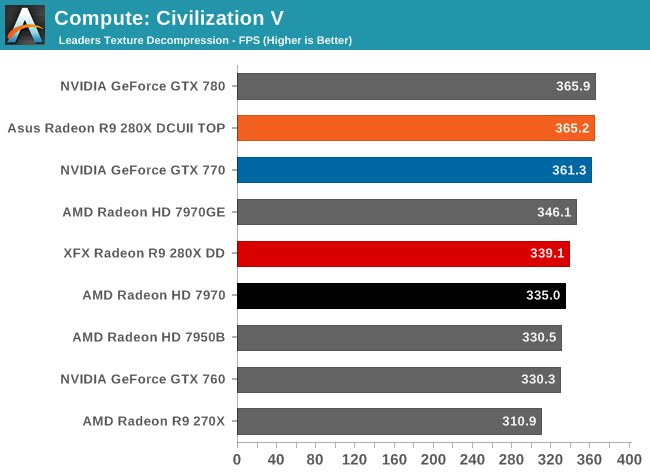
With Civilization V we’re finding that virtually every high-end GPU is running into the same bottleneck. We’ve reached the point where even GPU texture compression is CPU-bound.
Our next benchmark is LuxMark2.0, the official benchmark of SmallLuxGPU 2.0. SmallLuxGPU is an OpenCL accelerated ray tracer that is part of the larger LuxRender suite. Ray tracing has become a stronghold for GPUs in recent years as ray tracing maps well to GPU pipelines, allowing artists to render scenes much more quickly than with CPUs alone.
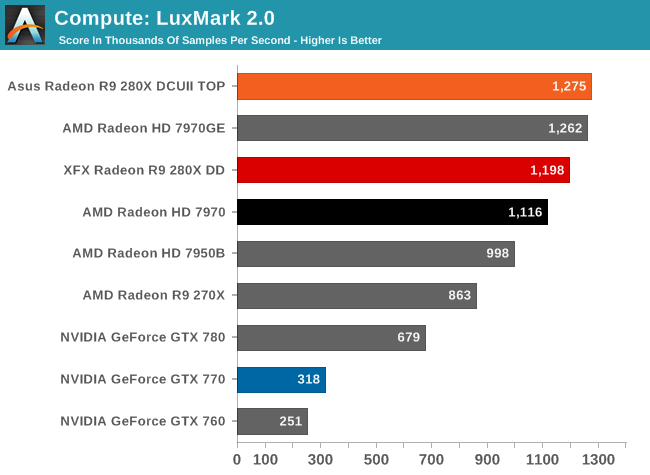
AMD simply rules the roost when it comes to LuxMark, so the only thing close to 280X here are other Tahiti parts.
Our 3rd compute benchmark is Sony Vegas Pro 12, an OpenGL and OpenCL video editing and authoring package. Vegas can use GPUs in a few different ways, the primary uses being to accelerate the video effects and compositing process itself, and in the video encoding step. With video encoding being increasingly offloaded to dedicated DSPs these days we’re focusing on the editing and compositing process, rendering to a low CPU overhead format (XDCAM EX). This specific test comes from Sony, and measures how long it takes to render a video.
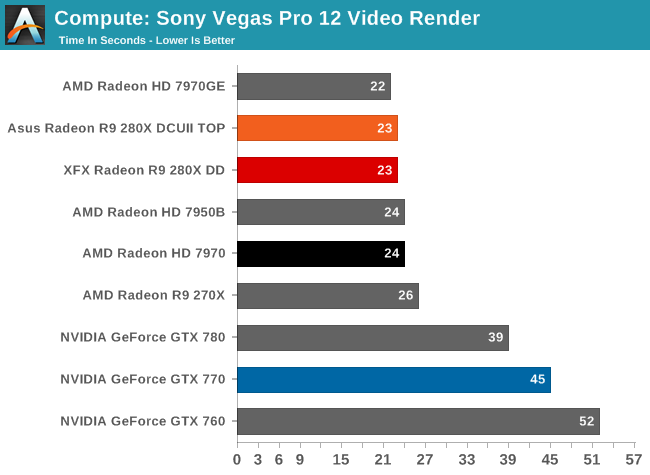
Again AMD’s strong compute performance shines through, with 280X easily topping the chart.
Our 4th benchmark set comes from CLBenchmark 1.1. CLBenchmark contains a number of subtests; we’re focusing on the most practical of them, the computer vision test and the fluid simulation test. The former being a useful proxy for computer imaging tasks where systems are required to parse images and identify features (e.g. humans), while fluid simulations are common in professional graphics work and games alike.
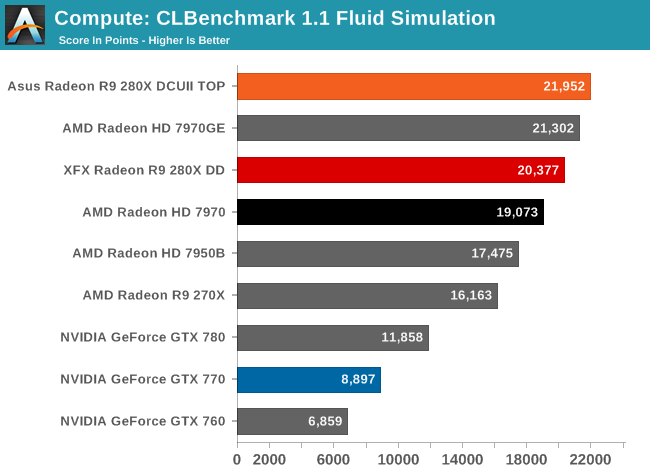
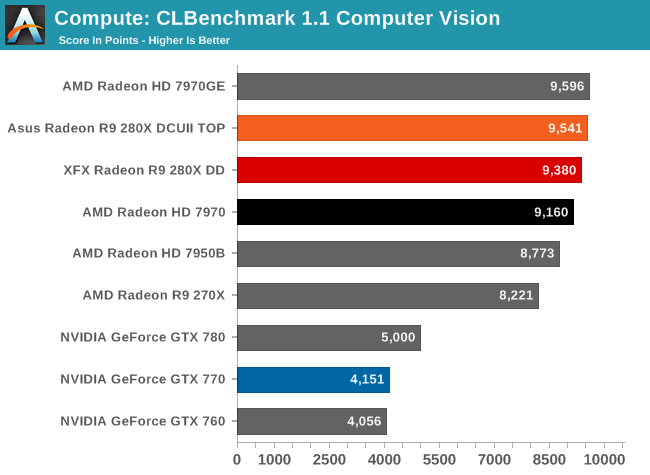
Despite the significant differences in these two workloads, in both cases 280X comes out easily on top.
Moving on, our 5th compute benchmark is FAHBench, the official Folding @ Home benchmark. Folding @ Home is the popular Stanford-backed research and distributed computing initiative that has work distributed to millions of volunteer computers over the internet, each of which is responsible for a tiny slice of a protein folding simulation. FAHBench can test both single precision and double precision floating point performance, with single precision being the most useful metric for most consumer cards due to their low double precision performance. Each precision has two modes, explicit and implicit, the difference being whether water atoms are included in the simulation, which adds quite a bit of work and overhead. This is another OpenCL test, as Folding @ Home has moved exclusively to OpenCL this year with FAHCore 17.

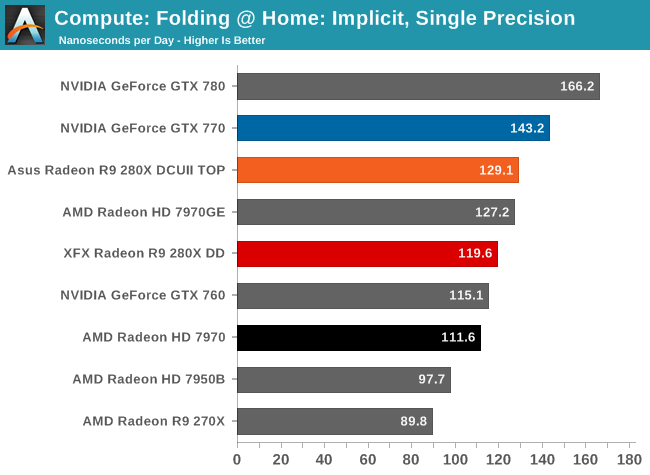

Depending on the mode and the precision, we can have wildly different results. The 280X does well in FP32 explicit, for example, but in implicit mode the 280X is now caught between the GTX 770 and GTX 760. But if we move to double precision then AMD’s native ¼ FP64 execution speed gives them a significant advantage here.
Wrapping things up, our final compute benchmark is an in-house project developed by our very own Dr. Ian Cutress. SystemCompute is our first C++ AMP benchmark, utilizing Microsoft’s simple C++ extensions to allow the easy use of GPU computing in C++ programs. SystemCompute in turn is a collection of benchmarks for several different fundamental compute algorithms, as described in this previous article, with the final score represented in points. DirectCompute is the compute backend for C++ AMP on Windows, so this forms our other DirectCompute test.
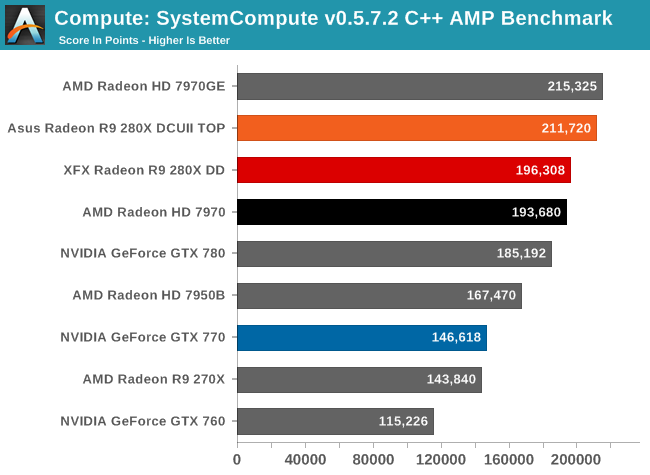
Although not by any means a blowout, yet again the 280X vies for the top here. When it comes to compute, the Tahiti based 280X is generally unopposed by anything in its price range.










151 Comments
View All Comments
Galidou - Saturday, October 12, 2013 - link
If he really has to whine about high end video card prices, he's new to this because many generations before, the top of the line was often sold for 800$. Anyway, if you simply run 1080p(which most of us does) you can be totally satisfied with a 150-300$ video card and two or three graphical options not maxed(you won't notice it unless you stop playing to just look at the graphics) which is quite different from older generations where you had to pay big bucks to run at higher resolution/graphical settings.I bought a 660ti for 300$ when it came out a year ago and I still run everything at very high/max settings in 1080p PERFECTLY. No reason to whine at all nowadays unless you're a kiddo that is new to the gaming industry and pc gaming gear.
Etern205 - Monday, October 14, 2013 - link
Many generations before top of the end graphic cards like ATi Radeon 9700 Pro, the best card of its time cost $300, and the 2nd best, ATi Radeon 9500 Pro cost just $200.High-end card is the past don't cost a arm and a leg, you can get one and still have enough to feed yourself for a week. Now they cost a arm and a leg, where you have to starve yourself for a month just to have enough to buy one.
hansmuff - Tuesday, July 14, 2015 - link
The Matrox MGA Millennium 4MB was $549 at launch and became a somewhat legendary performer in DOS VESA modes. That's 1995.bwat47 - Monday, December 9, 2013 - link
Yeah, a 280x was a steal for 299, excellent card.Anand Lal Shimpi - Tuesday, October 8, 2013 - link
We're working on it :) AMD gave Ryan very little time to go through four new cards, it's being added in real time here.Sunrise089 - Tuesday, October 8, 2013 - link
No disrespect Anand, but 'special relationship' with AMD notwithstanding, if they're asking you to have your article up at midnight for a launch but you can't even have product specs available by then I worry the advertising side of things is encroaching a bit into the editorial side.zanon - Tuesday, October 8, 2013 - link
Have to agree. I've always appreciated in the past that Anandtech would take the time to do reviews right, even if it very, very often meant that they'd come in days or more after the early rush. We've already got plenty of early rush stuff on the net that is of poor quality, please do not go that route. Just do a pipeline piece with early conclusions as you have before. You've got this going up across all twitter/rss/whatever feeds, everyone sees it and comes in, and it's a really poor showing.If AMD tells you to hit a certain launch window please kindly tell them to get stuffed or get your hardware earlier next time. If you're letting them rush you to their own schedule that feels like a really bad sign.
Anand Lal Shimpi - Tuesday, October 8, 2013 - link
See the above response, but I'd add: you don't have to worry about us going down the path of lowest common denominator. I hardly think that what was posted here at midnight was even close to fitting that description.Anand Lal Shimpi - Tuesday, October 8, 2013 - link
er below response :)chizow - Tuesday, October 8, 2013 - link
Easy guys, it's happened with other non-AMD reviews too in the past, I know other staff writers will often chip in and help with some aspects of the reviews, like tables and graphs, and sometimes the entire piece comes together online in real-time. It's like a big group project or presentation, sometimes it just doesn't go off perfectly on such short deadlines.